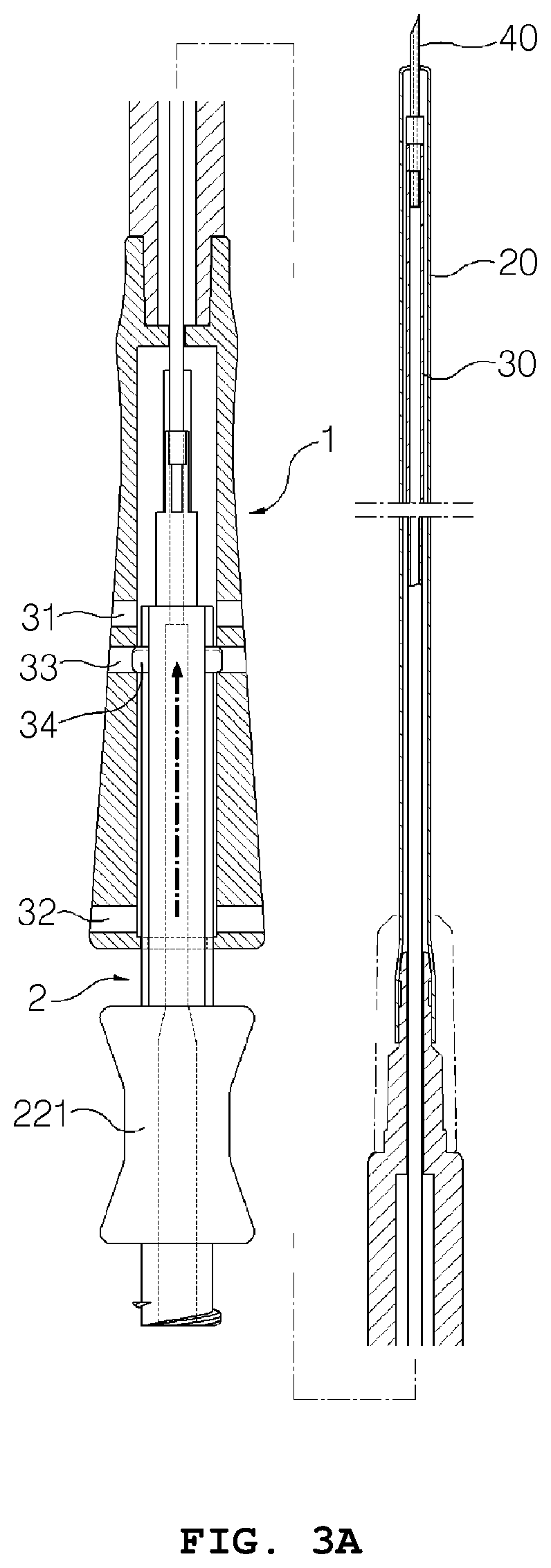Endoscopic treatment instrument having an inner and outer tube
a treatment instrument and endoscope technology, applied in the direction of surgery, catheters, applications, etc., can solve the problems of increasing treatment time, reducing the manipulability of the injection needle for an endoscope, and difficult to treat diseases safely, so as to facilitate easy manipulation and reduce frictional resistance , the effect of safe treatmen
- Summary
- Abstract
- Description
- Claims
- Application Information
AI Technical Summary
Benefits of technology
Problems solved by technology
Method used
Image
Examples
first embodiment
[0028]FIG. 1 is a view showing an endoscopic treatment instrument 10 according to the present invention, and FIG. 2 is a cross-sectional view of the endoscopic treatment instrument 10 shown in FIG. 1. FIG. 3A and FIG. 3B are views showing states of a needle protruding from the endoscopic treatment instrument 10 shown in FIG. 1.
[0029]An inner tube 30 is imbedded in an outer tube 20, and causes a through hole needle 40 to protrude from a front end part of the outer tube 20. The through hole needle 40 is mounted to the front end part of the inner tube 30 so as to communicate with the outer tube, and the manipulation part 5 is connected to a rear end part of the inner tube 30. The manipulation part 5 moves the inner tube 30 forward or backward relative to the outer tube 20 such that the through hole needle 40 protrudes from the front end part of the outer tube 20.
[0030]The manipulation part 5 includes a body tube 1, an operation member 2 inserted into the body tube 1 so as to move forwa...
second embodiment
[0046]FIG. 5 is a cross-sectional view of an inner tube 300 of an endoscopic treatment instrument according to the present invention. As shown in FIG. 5, though an inner circumferential surface 210 of the inner tube 300 is configured to have an even surface so as not to prevent the flow of medicine fluid, an outer circumferential surface 212 is configured to have protruding parts 214 so as to decrease an area in contact with an outer tube.
[0047]Table 1 shows manipulabilities when the material of the outer tube is polytetrafluoroethylene (PTFE). The inner tube 30 is inserted into the outer tube 20, the outer tube 20 is wound on a cylinder 160 mm in diameter, the inner tube 30 is connected to a push pull gauge, and the inner tube 30 is pulled. In this case, a pulled strength of the inner tube 30 is measured when the inner tube 30 comes out of the outer tube 20. In view of a maximum length of each instrument used in gastroscopy and colonoscopy, length of the outer tube 20 is set to be ...
PUM
| Property | Measurement | Unit |
|---|---|---|
| melting point | aaaaa | aaaaa |
| melting point | aaaaa | aaaaa |
| melting point | aaaaa | aaaaa |
Abstract
Description
Claims
Application Information
 Login to View More
Login to View More - R&D
- Intellectual Property
- Life Sciences
- Materials
- Tech Scout
- Unparalleled Data Quality
- Higher Quality Content
- 60% Fewer Hallucinations
Browse by: Latest US Patents, China's latest patents, Technical Efficacy Thesaurus, Application Domain, Technology Topic, Popular Technical Reports.
© 2025 PatSnap. All rights reserved.Legal|Privacy policy|Modern Slavery Act Transparency Statement|Sitemap|About US| Contact US: help@patsnap.com



